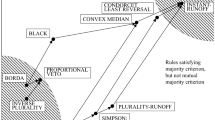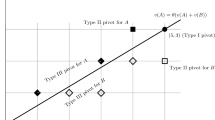Abstract
In a context of constitutional choice of a voting rule, this paper presents an economic analysis of scoring rules that identifies the golden voting rule under the impartial culture assumption. This golden rule depends on the weights β and (1−β) assigned to two types of costs: the cost of majority decisiveness (‘tyranny’) and the cost of the ‘erosion’ in the majority principle. Our first main result establishes that in voting contexts where the number of voters n is typically considerably larger than the number of candidates k, the golden voting rule is the inverse plurality rule for almost any positive β. Irrespective of n and k, the golden voting rule is the inverse plurality rule if β ≥ 1/2 .. This hitherto almost unnoticed rule outperforms any other scoring rule in eliminating majority decisiveness. The golden voting rule is, however, the plurality rule, the most widely used voting rule that does not allow even the slightest ‘erosion’ in the majority principle, when β=0. Our second main result establishes that for sufficiently “small size” voting bodies, the set of potential golden rules consists at most of just three rules: the plurality rule, the Borda rule and the inverse plurality rule. On the one hand, this finding provides a new rationalization to the central role the former two rules play in practice and in the voting theory literature. On the other hand, it provides further support to the inverse plurality rule; not only that it is the golden rule in voting contexts, it also belongs, together with the plurality rule and the Borda method of counts, to the “exclusive” set of potential golden voting rules in small committees.
Similar content being viewed by others
References
Austen-Smith D., Banks J.S. (1999). Positive Political Theory I: Collective Preferences. University of Michigan Press, Ann Arbor
Baharad E., Nitzan S. (2002). Ameliorating majority decisiveness through expression of preference intensity. Amn Polit Scie Rev 96(4):745–754
Baharad E., Nitzan S.(2003). The Borda rule, Condorcet consistency and Condorcet stability. Econ Theory 22(3):685–688
Baharad E., Nitzan S. (2005). Approval voting reconsidered. Econc Theory 26(3):619–628
Baharad, E., Nitzan, S.: Scoring rules: an alternative parameterization. Econc Theory (forthcoming) (2006)
Ben-Yashar R., Nitzan S. (1997). The optimal decision rule for fixed size committees in dichotomous choice situations—the general result. Int Econ Rev 38(1):175–187
Bordley R.F. (1983). A pragmatic method for evaluating election schemes through simulation. Am Polit Scie Rev 77:123–141
Buchanan J.M., Tullock G. (1962). The calculus of consent. University of Michigan Press, Ann Arbor
Chebotarev P.U., Shamis E. (1998). Characterizations of scoring methods for preference aggregation. Ann Oper Res 80:299–332
Dekel E., Piccione M. (2000). Sequential voting procedures in symmetric binary elections. J Polit Econ 108:34–55
Farkas D., Nitzan S. (1979). The Borda rule and Pareto stability: a comment. Econometrica 47:1305–1306
Gardenfors P. (1973). Positional voting functions. Theory Decis 4:1–24
Li H., Rosen S., Suen W. (2001). Conflicts and common interests in committees. Am Econ Rev 91:1478–1497
Myerson R.B. (2002). Comparison of scoring rules in Poisson voting games. J Econ Theory 103:219–251
Merrill S. III. (1984). A comparison of efficiency of multicandidate electoral systems. Am Polit Sci Rev 28:23–48
Mueller D. (2003). Public Choice III. Cambridge University Press, Cambridge, U.K
Nitzan S., Paroush J. (1982). Optimal decision rules in uncertain dichotomous choice situations. Int Econ Rev 23:289–297
Nitzan S., Rubinstein A. (1981). A further characterization of Borda ranking method. Public Choice 36:153–8
Rae D.W. (1969). Decision rules and individual values in constitutional choice. Am Polit Sci Rev 63:40–56
Richelson J.T. (1978). A characterization result for the plurality rule. J Econ Theory 19:548–550
Saari D.G (1990). The Borda dictionary. Soc Choice Welfare 7:279–317
Saari D.G. (1995). Basic Geometry of Voting. Springer, Berlin Heidelberg New york
Saari D.G. (2000). Mathematical structure of voting paradoxes II: positional voting. Econ Theory 15(1):55–102
Taylor M.J. (1969). Proof of a theorem on majority Rule. Behav Sci 14:228–231
Wicksell K. (1980). A new principle of just taxation. In: Musgrave R. and Peacock A.T. (eds) Finanztheoretische Untersuchungen, Jena, (1896), reprinted in Classics in the theory of public finance. McGraw Hill, New York
Young H.P. (1974). An axiomatization of Borda’s rule. J Econ Theory 9:43–52
Young H.P. (1975). Social choice scoring functions. SIAM J Appl Math 28:824–838
Author information
Authors and Affiliations
Corresponding author
Additional information
We are indebted to Jim Buchanan, Amichai Glazer, Noa Nitzan, Ken Shepsle, and an anonymous referee for their useful comments.
Rights and permissions
About this article
Cite this article
Baharad, E., Nitzan, S. The Costs of Implementing the Majority Principle: The Golden Voting Rule. Economic Theory 31, 69–84 (2007). https://doi.org/10.1007/s00199-006-0083-9
Received:
Accepted:
Published:
Issue Date:
DOI: https://doi.org/10.1007/s00199-006-0083-9




